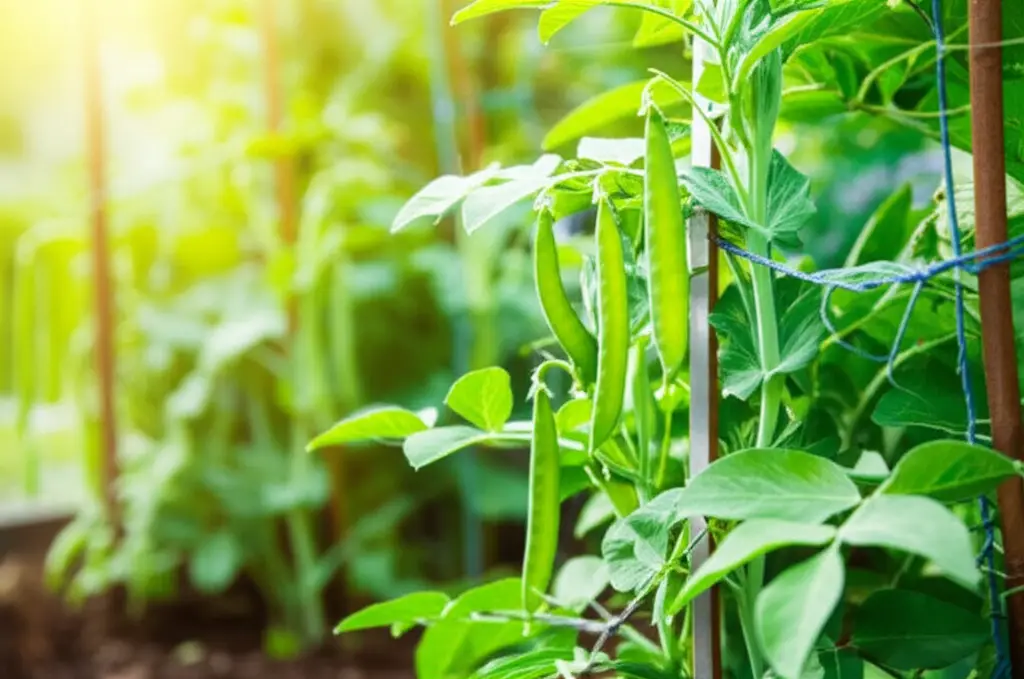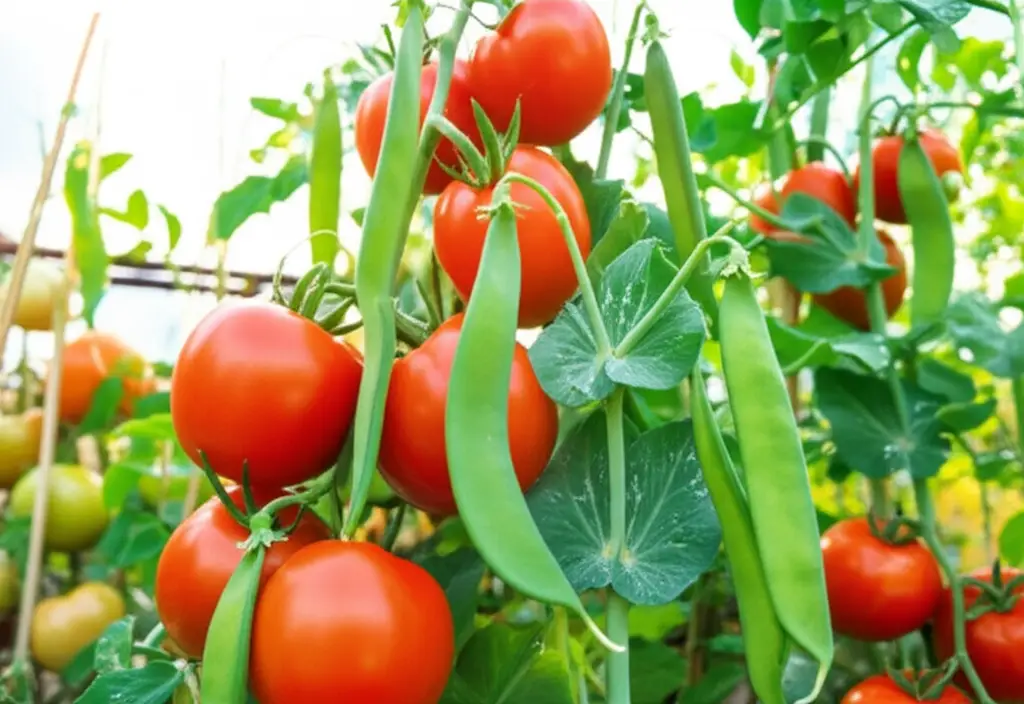This comprehensive guide explores the benefits and methods of companion planting peas with tomatoes, covering everything from soil preparation and planting schedules to pest control and maximizing yields. Discover the symbiotic relationship between these two popular garden vegetables and learn how to successfully grow them together for a thriving and productive garden.

Companion planting, the practice of growing specific plant species together for mutual benefit, can significantly improve your garden’s health and productivity. This guide focuses on the advantageous pairing of peas and tomatoes, providing practical advice and expert tips for achieving a bountiful harvest.
JUMP TO TOPIC
- 1 Understanding the Benefits of Companion Planting Peas with Tomatoes
- 2 Planting Peas and Tomatoes Together: A Step-by-Step Guide
- 3 Addressing Common Concerns about Companion Planting Peas and Tomatoes
- 4 Other Beneficial Companion Plants for Tomatoes and Peas
- 5 FAQs about Growing Peas with Tomatoes
- 6 Conclusion
Understanding the Benefits of Companion Planting Peas with Tomatoes
Companion planting isn’t just an old gardening trick; it’s a science-backed method rooted in understanding plant interactions. Growing peas and tomatoes together offers several distinct advantages:
Improved Soil Health: Peas, being legumes, fix nitrogen in the soil. This nitrogen enrichment directly benefits tomatoes, which are heavy feeders and require nutrient-rich soil for optimal growth. This natural fertilization reduces the need for synthetic nitrogen-based fertilizers.
Pest and Disease Control: The strong scent of tomato plants can deter certain pests that commonly affect peas, such as aphids. Conversely, peas can attract beneficial insects like ladybugs that prey on tomato pests.
Space Optimization: The vining nature of peas allows them to grow vertically, utilizing vertical space while tomatoes occupy the ground level, maximizing the use of garden space.
Enhanced Growth: Studies suggest that the chemicals released by peas can stimulate tomato growth, leading to larger and more abundant yields.
Reduced Weed Growth: The dense foliage of peas can suppress weed growth, minimizing competition for resources and reducing the need for frequent weeding.
Planting Peas and Tomatoes Together: A Step-by-Step Guide
Soil Preparation and Planting Schedule
Soil: Both peas and tomatoes thrive in well-drained, nutrient-rich soil with a slightly acidic pH (6.0-7.0). Amend the soil with compost or well-rotted manure before planting.
Timing: Plant peas in early spring, as soon as the ground can be worked. Tomatoes, being warm-season crops, should be planted after the last frost, typically a few weeks after peas.
Spacing: Allow adequate spacing between tomato plants (around 2-3 feet) to ensure proper air circulation and prevent overcrowding. Plant peas in rows or along trellises near the base of the tomato plants, ensuring they don’t shade the tomatoes excessively. More on this below.
(Internal link to an article about ideal soil preparation for vegetable gardens could be added here)
Supporting Structures and Vertical Gardening
Providing support for both peas and tomatoes is crucial for maximizing yields and preventing diseases.
Tomato Supports: Use stakes, cages, or trellises to support tomato plants as they grow. This not only keeps the fruit off the ground but also improves air circulation, reducing the risk of fungal diseases like blight.
Pea Trellises: Peas are natural climbers and benefit greatly from trellises or netting. This vertical growth optimizes space and makes harvesting easier.
(Internal link to an article about DIY garden trellises could be added here)
Watering and Fertilizing
Watering: Water deeply and regularly, especially during dry periods. Ensure the soil is evenly moist but avoid overwatering, which can lead to root rot.
Fertilizing: While peas fix nitrogen in the soil, tomatoes require additional nutrients. Apply a balanced fertilizer (e.g. 10-10-10) or compost tea every few weeks during the growing season.
Pest and Disease Control
Monitoring: Regularly inspect both plants for signs of pests or diseases. Early detection is key to effective control.
Natural Pest Control: Encourage beneficial insects by planting flowers like marigolds and using natural pest control methods like neem oil or insecticidal soap.
Disease Prevention: Ensure good air circulation by proper spacing and pruning, and avoid overhead watering to prevent fungal diseases.
Addressing Common Concerns about Companion Planting Peas and Tomatoes
One common concern about companion planting peas and tomatoes is the potential for peas to inhibit tomato growth. However, studies have shown that properly spaced peas do not negatively impact tomato yields and can even enhance growth by providing nitrogen. Additionally, ensuring adequate sunlight for both plants is essential.
Other Beneficial Companion Plants for Tomatoes and Peas
While peas and tomatoes make a good pair, other companion plants can further benefit your garden.
Basil: Repels insects and improves tomato flavor.
Carrots: Loosen the soil, benefiting peas and tomatoes.
Marigolds: Deter nematodes and other soil pests.
Nasturtiums: Attract beneficial insects and act as a trap crop for aphids.
Borage: Attracts pollinators and improves tomato growth.
(Internal link to an article about other companion planting techniques could be added here)
FAQs about Growing Peas with Tomatoes
Q: Will peas stunt tomato growth?
A: No, properly spaced peas generally do not stunt tomato growth and can even improve it by fixing nitrogen in the soil.
Q: When is the best time to plant peas and tomatoes together?
A: Plant peas in early spring and tomatoes after the last frost, ensuring they have enough space and sunlight.
Q: What type of support is best for peas and tomatoes?
A: Use stakes, cages, or trellises for tomatoes and netting or trellises for peas.
Q: How often should I water peas and tomatoes?
A: Water deeply and regularly, keeping the soil evenly moist but not waterlogged.
Q: What other plants can I grow with peas and tomatoes?
A: Basil, carrots, marigolds, nasturtiums, and borage are all beneficial companions.
Conclusion
Companion planting peas with tomatoes is a smart gardening strategy that offers a multitude of benefits, from improved soil health and pest control to enhanced growth and maximized yields. By understanding the specific needs of each plant and following the guidelines outlined in this guide, you can create a thriving and productive garden that benefits from the symbiotic relationship between these two popular vegetables. Remember to choose appropriate supporting structures, manage watering and fertilization effectively, and monitor for potential pests and diseases. This holistic approach will contribute not only to a successful harvest but also to a healthier and more resilient garden ecosystem. Enjoy the fruits (and peas!) of your labor!
(Ideally, links to product pages related to gardening tools, seeds, fertilizers, etc., would be integrated throughout the content where relevant)

